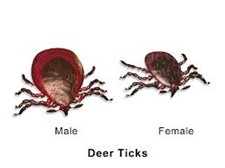Tick- Borne Illnesses and Lyme Disease

How can you protect yourself from Ticks?
Check out the CDC's website for valuable information about Ticks, Prevention and Tick-Borne illness.
Lyme Disease information
The University of Medicine and Dentistry of NJ has developed new educational tools to teach children how to avoid tick-borne diseases and reduce pesticide use. The free tools are posted at the Lyme Disease Association website.
What Is Lyme Disease?
Lyme disease is an infection caused by bacteria called Borrelia burgdorferi.
How is Lyme Disease transmitted?
The bacteria are transmitted to people and animals by the bite of an infected black-legged tick, Ixo des scapularis, commonly called the deer tick. Although other types of ticks and some insects have been shown to carry the Lyme bacteria, to date, transmission of Lyme through those vectors has not been proven.
The bacteria can also be passed through the placenta of a pregnant woman to the fetus—congenital transmission.
The DNA of the bacteria has been found in breast milk, but no transmission has been proven to date in humans.
The Lyme bacteria have been proven to survive blood banking conditions; however, to date, no transmission has
been proven through blood transfusions in humans. Studies have shown transmission through this route in mice in the lab.
Check out the Lyme Disease Association's website for great resources and printable materials to educate yourself about Lyme disease and other Tick-Borne Illnesses.
